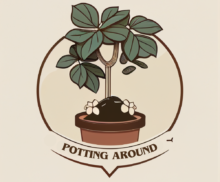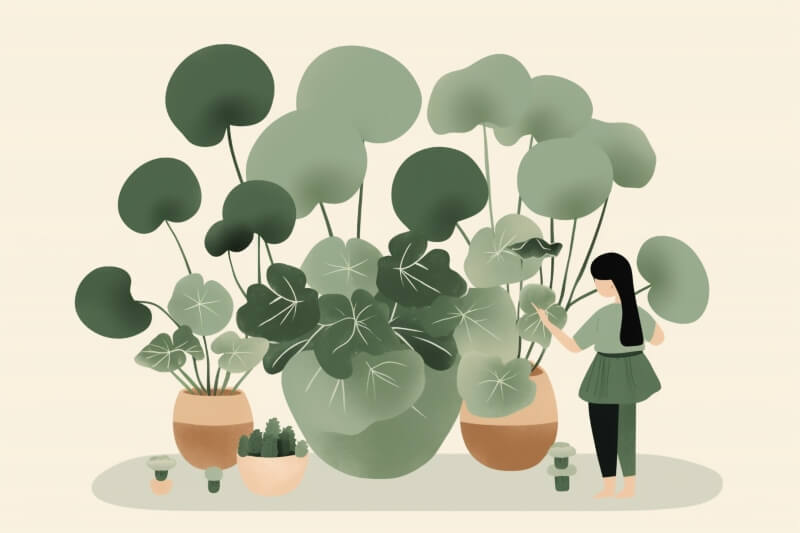You just finally put your hand on a pilea? Here’s everything you need to know about this funny looking plant.
In this article:
What is a pilea?
Pilea peperomioides, also known as “Chinese money plant” or “friendship plant”, or – personal favourite – the “pancake plant”, is a succulent type of plant. It’s known for its playful look with its characteristics flat, coin-shaped leaves.
Originated from the mountains of the southwestern Yunnan province of China, it was first brought back in Norway in the 1940’s. Fun fact, this quirky plant is thought to bring good fortune, money and abundance to its owner.
It’s part succulent, meaning it stores water in its bright green, round-shaped leaves. This makes it particularly resilient to periods of draught, or if you forget to water it for a while.
A healthy pilea will grow super fast. They sprout tiny “pups” which you can propagate or give to your friends to start their own plants – hence why it’s called the friendship plant.

How to care for a pilea
Pilea peperiomioides are very easy to care for. They’re fast growing and low maintenance, making them the perfect choice for beginners plant owners.
Here’s how to take care of it.
Light
Pileas are not too fussy. The main thing these plants need is bright, indirect light. Keep it by a sunny window (south facing if you can) and it’ll push new leaves every week.
If it gets very sunny, move it a few feet away from the direct light. This risks scorching the leaves (if you see tiny brown specks or light green spots appearing on the leaves, this indicates sun damage).
If you don’t have south facing windows, that’s fine. It can still grow by an eastern or even northern window – although more slowly. You’ll know that your plant needs more light if the leaves are on the small side or start curling. If that’s happening, move it to a brighter spot.

Watering
How often you water your pilea will depend on the size of your plant and the season. As a general rule of thumb, an adult plant needs watering every 10 days in Winter versus every 7 or 8 days in Summer.
Typically, you’ll know when to water your pilea by looking at its leaves. When the plant needs watering, it will become slightly droopy, and the leaves will look softer and less shiny. That’s when you know your pilea needs watering. If you’re not sure, check the first few centimetres of soil and make sure it’s dry before watering. If still humid, wait a couple more days to avoid overwatering and causing root rot.

Water thoroughly and make sure the water runs through the drainage hole at the bottom of the pot. You should see it plump back up after a couple hours.
Allow the soil to get completely dry before the next watering.
Soil
You can use an indoor potting mix for your pilea, or even better, cactus soil mix (with added sand or perlite for instance). It is more draining that regular soil which seems to make the plant happy. Avoid any type of medium that increases the level of soil humidity like peat moss as it risks causing your pilea to turn yellow as a sign of protest.
Keeping your plant in a terracotta pot will help with drainage and absorbs any excess water while letting the soil dry. But any pot with good drainage should do. If you’re looking for inspiration, you can check this post on the best places where to buy cool pots.
Repotting
Provided it gets a good amount of light, your pilea will grow from fast to really fast. Given that it receives a good amount of light, it will take only a few months to grow from a pup to full grown adult plant. At some point you might need to repot it.
If it looks crammed with lots of pups, repot in a bigger pot. Another way to tell is to by pulling it from its pot to check the roots. If you see more roots than soil, then you know it’s time to up-pot.

How to propagate a pilea
Now, that’s where the fun begins. Pilea is known for sprouting a lot of pups.
Like, a lot.
Once they’re big enough, you can separate them from the mother plant and give them for adoption.

Propagating a pilea is quite simple. Wait until the pup is big enough to survive and grow its own root system – usually when it’s about 5 to 7 cm high. Then, gently dig the first 2 to 4 cm of soil around the roots. Take a sharp knife and make a clean cut to separate it from the mother plant. Make sure to keep some of the roots attached to the pup.
That’s it, you’ve done your first pilea propagation.
If your pup already has roots, you can directly plant it back – preferentially in the same mix than the mother plant. If it doesn’t have any roots, place it in a glass of water for a few days, making sure that no leaf touches the water. Wait until it starts developing its own roots. This can take between 10 to 14 days before repotting it.
Can I propagate a pilea from a leaf?
Now, at some point your pilea will inevitably start shedding leaves. It can be seasonal or for any other reasons, that’s just part of life. If one of the roots falls off and if you leave it in water long enough, it will starts sprouting some new roots. You can then go ahead and repot it if you’d like. Evidence suggests that the stem only doesn’t contain the necessary cells to grow an entire plant. But you never know, yours might be the exception. If you’re really into propagation, you can also a look at this post on the the best plants to propagate.
Are pilea toxic to cats and dogs?
Luckily for all cat and dog lovers, pileas are fine to have with pets as it is not toxic. Succulents also tend to look less appetising to cats than a dangly spider plant. That’s not to say you shouldn’t keep an eye on your pet, as they might still find it yummy…
Common pilea problems
Why is my pilea drooping?
If your pilea isn’t looking as perky as it used to, or if it starts drooping, it might just be thirsty. Start by checking the level of soil humidity. If the first centimetres are completely dry, give it a little water. If after a few hours, it’s still not back to normal, it might be something else. How long have you had the plant for? Was it recently moved or shocked? Does it look a bit crammed? Maybe it’s time for up-potting.
Why is my pilea turning yellow?
There are multiple reasons why a pilea can turn yellow. Seasonal change, improper soil moisture, natural plant aging, or sometimes it just needs a little fertilizer. Start by asking yourself if you change something in your plant care routine. Have you recently watered or changed the soil? Is there any reasons why the plant might be protesting?

If you’re going towards Winter, it might also be just normal shedding. Pileas lose their bottom leaves at the end of the growing season and push fresh new ones when Spring return. So if you see older, bottom leaves yellowing, that might be just normal.
Why is my pilea turning brown?
If your pilea is turning brown and mushy, then it’s often due to a watering issue. Check the bottom of the pot for any excess water and make sure you choose a pot with drainage. Like many other plants, pileas don’t like having their feet are wet.
It can also be the sign or something more serious, like pest or disease.

If you notice tiny little brown specks on the leaves, don’t worry too much. These can be caused by physical damage (e.g. the plant fell off) or sun damage. If your plant is in a sunny spot and you don’t want the leaves to get damaged, push it a bit further from direct sunlight.
Why does my pilea have white spots?
If your pilea has white spots at the back of the leaves, don’t panic. This doesn’t necessarily mean it has a disease. Those little white specks are caused by minerals in the water. Most of the pileas have them. If you want to avoid them, you can use distilled water, or rain water.
Why my pilea leaves are curling?
There are a lot of theories online about why pilea leaves curl. As a general rule of thumb, if your pilea leaves start curling, you can assume that it has something to do with lighting. Have a look at its environment. Is it a few meters away from the window? Does it sit on the northern side of your house? If so, consider moving to a sunnier and you should see the leaves flattening out.
Why is my pilea not growing?
Pileas are fast grower, so given that you provide with the right conditions, you should see new growth pushing ever other day or week. If your pilea looks like it’s not growing, consider moving it to a sunnier spot as the lack of light might impact its growth. During Spring, you can also give it a little fertilizer every other week to boost its growth.


